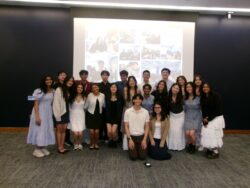“Does anyone know what special day it is at Georgetown? Every day is a special day at Georgetown!” After reciting our introductions for the umpteenth time, we rush out into the heat or the rain or the freezing cold, armed with Hydro Flasks and our best smiles.
For many prospective students, their impression of Georgetown starts with a 75-minute tour given by student guides from the Blue & Gray Tour Guide Society. As volunteers, Blue & Gray (B&G) guides have never been officially compensated, and we say on tours that we volunteer our time as guides because we love Georgetown!
Being a tour guide means generally presenting Georgetown positively to visitors. But as three guides of color, we often tiptoe between spouting the information the Office of Undergraduate Admissions might prefer us to share (though they do not directly control our tour content) and acknowledging our lived experiences beyond the brochures.
To create a more representative and equitable picture of Georgetown, tour guides must be paid. Even more importantly, our tours must fully address Georgetown’s legacy of racism and the role of student activists in addressing our institution’s flaws.
In our experience, B&G has underrepresented students of various identities, prominently students of color and first-generation, low-income (FGLI) students. While currently B&G meets or overrepresents some aspects of the university’s demographic diversity, the university underrepresents these identities at large. Unfortunately, this means it is often white, privileged students with largely positive impressions of Georgetown who give one-dimensional tours, omitting critical information about the experiences of FGLI students on campus.
One solution proposed time and time again to increase equity in B&G is to pay guides. Our peer institutions—including American University and all Ivy League universities—pay their guides. Even at Georgetown, we’ve heard of select guides already getting paid due to staffing shortages in the summer; Admissions pays guides who are employed directly by their office, whose tours equal unpaid guides’ tours in quality and content.
B&G’s recent statement regarding the payment of guides argues that compensation results in reduced tour quality, less honest tours, and a reduced number of guides. But in regard to quality, B&G’s rigorous training would stay the same even with compensation, and it is wrong to assume that guides—especially those of marginalized identities—would share less of their honest experiences if they were compensated by the university. And Georgetown receives an estimated $1.5 million every admissions cycle from undergraduate applicant fees, and Admissions could easily dedicate 5 percent of that revenue to pay every guide. In fact, many, if not all, of our peer institutions have more than 20 guides and manage to pay them. And if Admissions tries to cite these disproven strawman arguments to justify not paying guides, B&G leadership and every tour guide should fight for compensation.
But to actually advance equity at Georgetown, paying guides is not enough.
Beyond compensation, tours must be reframed to reflect Georgetown’s legacy of racism and colonialism. Tours do not include that our school colors—blue and gray—reference how Georgetown wanted to appease Hoyas who fought for both the Union (blue) and the slaveholding Confederacy (gray). Key figures like John Carroll, SJ., and William Gaston were, up until a recent slew of trainings, glorified without context about how they both contributed to enslavement and colonization.
Our discussion of student activism also lacks emphasis on the unfair labor and burden placed on students of marginalized identities to fight tooth and nail for justice. While our tours’ main goal should still be promoting Georgetown, B&G can increase equity by further integrating the history of Georgetown’s structural inequities into tours. We must also explain the role of student activism in exposing flaws within Georgetown’s institutions today, such as GUPD and the Office of Institutional Diversity, Equity & Affirmative Action, which have both failed to properly aid survivors of hate crimes.
Not only is the exclusion of this context a disservice to prospective students who don’t come from privileged backgrounds, but it also explains why many FGLI students are uninterested in applying to B&G—it’s often perceived that guides must only speak positively about Georgetown or present an experience they don’t identify with. Yet this isn’t about telling students that “Leo’s food sucks” or “Darnall has rats.” This is about portraying Georgetown through diverse narratives to show how a predominantly white institution can become a home for anyone. Equity cannot increase at Georgetown until we confront—not whitewash—our history and institutions to visitors.
We cannot delay change. Privilege trickles down in B&G: Affluent and white guides often hold intrinsic biases towards club applicants similar to them, which leads to cyclical rehiring of privileged, white students. This cements the image to visitors that the students who love their time here at Georgetown are affluent and/or white. As more privileged students decide to apply, Georgetown remains inequitable. Of course, it’s not B&G’s fault that Georgetown is a campus where 50 percent of students come from the top 5 percent of American households. As guides, however, we’re taught that one tour can have a surprisingly lasting influence on prospective students.
Without compensation and structural changes to our tours, B&G’s initiatives to connect with underrepresented groups are performative. For instance, B&G has long aimed to interest more students of marginalized identities in applying, including members of the Georgetown Scholars Program (GSP), an organization dedicated to helping FGLI students navigate campus. Yet, GSP students continue to be underrepresented within B&G. Paying guides and reframing tours could encourage FGLI students—who are often also students of color—to join B&G. Having more guides of color means that visitors of historically underrepresented backgrounds could hear from someone with representative experience, a small step toward increasing equity at Georgetown.
Admissions must approve efforts to compensate guides and reframe our tours to reflect marginalized students’ experiences. For years, guides have sought compensation, and student organizations have demanded inclusive changes to tour content. Charles Deacon, the undergraduate admissions dean, even conceded that Georgetown falls short in its diversity.
If Admissions continues to resist changing tour content and implementing compensation equitably, B&G—from its leadership down to every guide—must take direct action to stop the flow of privilege from trickling down. Vanderbilt guides even protested their administration and threatened to strike for compensation, with a letter signed by their tour guide executive board. If we want to increase equity at Georgetown, it begins with reforming Blue & Gray.
This article has been updated after print publication to correct factual inaccuracies about Blue & Gray’s tour guide demographics and recent changes to tour guidelines.





Disappointed that guides and the Voice did not do their due diligence fact checking this article. Two out of the three authors haven’t given a tour since August. Blue and Gray has significantly reformed the tour route to discuss more advocacy and has held bias training to ensure the statistics of our organization reflect the demographics of our organization. More than half of Blue and Gray self identifies as non white. The article does nothing to empower students of color to represent the school, but instead convinces them that it is a flawed organization that they should not even join.
It’s a shame that Blue and Gray leadership would imediately shame three tour guides of color for expressing their opinions and dissenting against issues they see within the organization — it only further reinforces some of the notes I resonated with in the piece that leadership can and must do more to fight for guides of color. Even if you’re discussing advocacy (after a hate crime happened), that doesn’t negate the fact that guides can gloss over this information & that I saw guides this year purposefully move around GUPR sit-ins and not mention it at all.
On top of that, it’s unfortunate that leadership is *flagrantly* violating confidentiality by publicly shaming which guides aren’t giving tours & aren’t attending meetings/workshops (yikes!). And this doesn’t begin to account for the fact that Blue and Gray *only* published a ‘transparency statement’ on guide payment…after…they hired Spring guides — a statement predicated on long disproven arguments (if you polled guides today, how many would want compensation?).
Let’s BFFR: if you ctrl-f this piece, nowhere does it ever say that Blue and Gray is “a flawed organization that [students of color] should not even join.” If you’re going to seriously address the concerns that students of color have, instead of attacking a piece that doesn’t exist,,,,and,,,giving students of color the burden of showing up to yet another ‘discussion,’ you should actually work towards communicating a clear roadmap for how you will enact the changes that guides have already demanded for years.